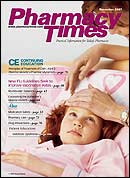Publication
Article
Pharmacy Times
DIABETES WATCH
Risk of Death from PneumoniaHigher with Diabetes
Patients with diabetes or elevated blood sugar facegreater odds of dying after being hospitalized for pneumonia,according to a study of nearly 30,000 adults with a firsttimehospitalization for pneumonia between 1997 and 2004.
The researchers found that mortality rates at both 30 and90 days after hospitalization were higher in patients withdiabetes, compared with patients without diabetes (20% vs15% and 27% vs 22%, respectively). On admission to the hospital,the study indicated that a high blood sugar levelincreased the risk of death by 46% in patients with diabetesand by 91% in patients with undiagnosed diabetes. Reportingin Diabetes Care (September 2007), the researchers concludedthat, in patients with pneumonia, much of the elevated illnessand death seen with diabetes is mediated through thepresence of high blood sugar.
Diabetes Care Too Much forSome Patients
Reporting in the October 2007 issue of Diabetes Care,researchers found that patients with diabetes viewed adhering totheir daily regimen just as burdensome as diabetes-related healthcomplications.
Some patients said the discomfort of having to take multiplemedications daily, carefully monitoring their diet, and gettingthe required amounts of exercise had significantly impactedtheir quality of life. Of the 700 patients, 12% to 50% said theywould be willing to give up 8 of 10 years of life in perfect healthto avoid a life with diabetes complications. Yet, between 10%and 18% of patients reported they were willing to sacrifice 8 of10 years of healthy life to avoid life with treatments.
The findings showed "that we need to find better, more convenientways to treat chronic illness," commented lead authorElbert Huang, MD.
Initiative Highlights Diabetes and CVD Connection
The national campaign Control Your Diabetes. For Life. willreach out through a network of 200 partners to health careprofessionals and their patients to emphasize the importanceof comprehensive control of diabetes and cardiovasculardisease (CVD). Patients with diabetes face anincreased risk of CVD.
The free educational materials include 4 Steps to ControlYour Diabetes. For Life., a brochure to help diabetes patientsmanage their disease; Take Care of Your Heart. Manage YourDiabetes, a tip sheet about the link between diabetes andheart disease with tips on how to manage the ABCs of diabetes;Guiding Principles for Diabetes Care, a guide to helphealth care professionals learn more about the essentialcomponents of diabetes care; and Diabetes Numbers At-a-Glance, a laminated pocket guide with a list of current recommendationsfor clinicians to diagnose and manage diabetes.
The National Diabetes Education Program launched theinitiative with sponsorship by the National Institutes ofHealth and the Centers for Disease Control and Prevention.For more information, visit www.ndep.nih.gov.
Take a Breath
Researchers may have found analternate test to replace finger-sticktesting in patients with type 1 diabetes.Because children exhale higher levelsof the chemical methyl nitrates whentheir blood sugar is too high, theresearchers suggested a simple breathtest.
University of California researcherPietro Galassetti, MD, PhD, said thatpatients with type 1 diabetes have tomonitor their blood sugar levels frequentlyusing devices that prick theskin to extract a small amount of blood."It's invasive. It's painful, and it can beexpensive," he said. "What we are tryingto do here is to come up with somethingcompletely noninvasive."
He said it may be possible to developa breath analysis test to screen bloodsugar, according to the study findingsreported in the September 25, 2007,issue of the Proceedings of the NationalAcademy of Sciences.
Experts Tell Patients: Get Regular Eye Exams
Patients with diabetes are more likely to have their visionchecked if they have access to health care and informationabout the importance of screenings, according to a studyreported in the American Journal of Preventive Medicine(October 2007).
Researchers analyzed data from 48 studies focused on theefforts to raise awareness among patients with diabetes. Theanalysis showed that increasing patient and provider awarenessof diabetic retinopathy, improving access to health care,and collaboration among local organizations that provideretinal screening were effective interventions.
The American Diabetic Association urges patients with diabetesto have their vision checked with dilation every year.Recent data indicate, however, that only 47% do.
F A S T F A C T : Heart disease and stroke account for about 65% of deaths in individuals with diabetes.







